Valley of Flowers Trek 2025 | Itinerary, Best time, Difficulty
Published on August 12, 2025
Valley of flowers tour package, The Valley of Flowers Trek 2025 is one of the most breathtaking journeys you can take in the Himalayas. Located in Uttarakhand, this UNESCO World Heritage Site is famous for its vast meadows covered with colorful blooms, snow-capped peaks in the background, and a refreshing mountain breeze. Every summer, nature turns this valley into a vibrant carpet of flowers, attracting trekkers, nature lovers, and photographers from all over the world.
Whether you are a beginner or a seasoned trekker, the Valley of Flowers offers the perfect mix of beauty, adventure, and peace.

Valley of Flowers Trek 2025 – Itinerary (6 Days / 5 Nights)
DAY 1: Depart from Rishikesh
- Upon reaching Rishikesh, head to 60's cafe ( The Beatles ), the starting point of your scenic journey to Govindghat / Pipalkoti.
- Enjoy breathtaking views of mountains and valleys en route.
- Check in to your accommodation and stay overnight.
DAY 2: Trek from Govindghat / Pipalkoti to Ghangaria
- Today, begin your 9km trek to Ghangaria, a peacful village nestles amidst forests and mountains.
- Enjoy the fresh mountain air and scenic views along the way.
- Upon arrival, check into your camp and explore the serene surroundings.
DAY 3: Trek from Ghangaria to Valley of Flowers
- In the morning, begin the exciting trek to the famed valley of Flowers.The trail is steep and rocky, but the stunning views make it worth the effort.
- Spend time soaking in the beauty before returning to Ghangaria.
DAY 4: Trek from Ghangaria to Hemkund Sahib
- Wake up early for the challenging trek to Hemkund sahib, with a steep ascent where a trekking stick is helpful.
- Enjoy views of snow-capped peaks and the pristine Hemkund lake.
- Spot the rare Bramhakamal flowers near the gurdwara, spend some peacful moments, and then return to Ghangaria for an ovenrnight stay.
DAY 5: Downhill Trek from Ghangaria to Govindghat / Pipalkoti
- In the morning, you will be starting the easy descent to Govindghat on the same trail that you trekked on earlier.
- After travelling through the same trail and witnessing the attractions and beauty from a different perspective, you will reach Govindghat.
- Upon reaching, settle into your Accommodation for an overnight stay.
DAY 6: Transfer to Rishikesh
- Begin your day by returning back to Rishikesh.
- As you reach rishikesh, your valley of Flowers Trekking package ends here, take a bundle of unbelievable memories with you.

Best Time to Visit the Valley of Flowers in 2025
The Valley of Flowers is a seasonal paradise, and its beauty changes every month. In 2025, the best time to visit will be from July to September, when nature paints the valley in vibrant colors, fresh fragrances, and breathtaking scenery.
July – The Beginning of Bloom
As soon as the first monsoon showers touch the Himalayas, the valley wakes up from its winter sleep. By early July, tiny buds start appearing, and by mid-month, fresh blooms cover the meadows. You’ll see bright colors like yellow, pink, and blue scattered like a natural carpet. The air is fresh, streams are gushing with crystal-clear water, and the surroundings feel alive. If you want to see the birth of the season, July is perfect.
August – Peak Flowering Season
August is when the Valley of Flowers truly lives up to its name. This is the most colorful month, with thousands of flowers in full bloom, from rare Himalayan orchids to Brahma Kamal. The weather is pleasant, the greenery is at its richest, and every turn on the trail looks like a painting. It’s also the best time for photography and nature walks. However, this is also the busiest month, as travelers from all over the world arrive to witness this natural wonder.
September – Calm, Crisp, and Magical
September brings a quieter charm to the valley. The flowers are fewer compared to August, but the scenery is still breathtaking, with a gentle mix of colors and a hint of autumn gold. The weather is cooler, the skies are clearer, and the crowd is much smaller. This is ideal for travelers who want peace, calm, and time to soak in the beauty without rush.
✅ Tip: Whether you choose July for freshness, August for peak bloom, or September for tranquility, make sure to book your Valley of Flowers Tour Package in advance, especially if you’re joining a Valley of Flowers tour package from Delhi, Rishikesh, Mumbai, or Haridwar. Fixed departures and guided tours help you enjoy the trek stress-free.
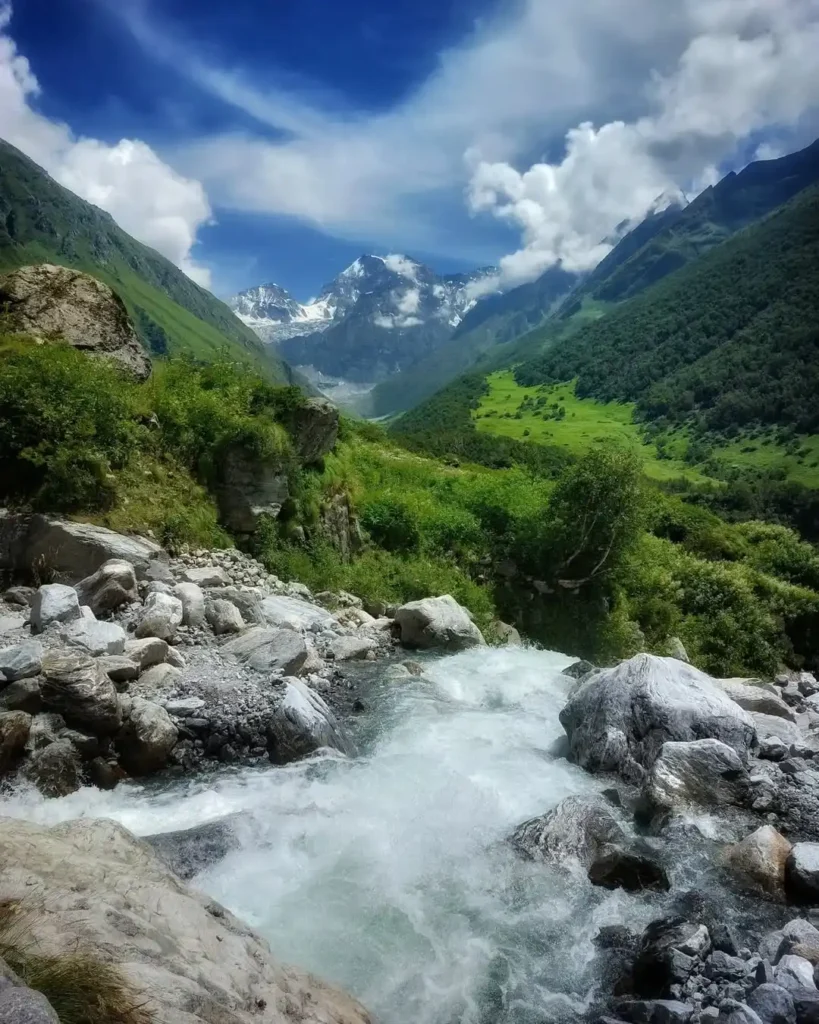
Valley of Flowers Trek Difficulty Level – A Complete Guide
The Valley of Flowers trek in Uttarakhand is one of the most scenic treks in India. While it’s not the toughest in terms of technical climbing, it does have challenges that every traveler should be aware of. The difficulty level is generally moderate, which means that with basic preparation, most people can complete it without much trouble.
Here’s a detailed breakdown:
1. Trekking Distance & Duration
-
From Govindghat to Ghangaria: About 13 km, which can take 5–7 hours depending on your pace.
-
From Ghangaria to Valley of Flowers: Around 3–4 km one way (6–8 km round trip).
-
Total Trekking Days: Usually 3 trekking days, excluding travel days.
-
You’ll be walking continuously, so stamina is more important than speed.
2. Trail Condition
-
The path is well-defined and safe, but it’s mostly uphill from Govindghat to Ghangaria.
-
Expect rocky steps, uneven ground, and occasional steep stretches.
-
During monsoon (July–August), parts of the trail can be slippery and muddy, requiring careful footing.
3. Altitude Challenges
-
The trek starts around 6,000 ft and reaches 14,000 ft at Hemkund Sahib (if included in your itinerary).
-
Higher altitudes mean less oxygen, which can cause tiredness and mild headaches for some.
-
Taking short breaks and staying hydrated helps prevent altitude sickness.
4. Physical Fitness Required
-
You don’t need to be a professional trekker, but basic fitness is important.
-
If you can walk 4–5 km daily for a week without getting overly tired, you’re ready.
-
Cardio exercises like walking, jogging, or cycling for a month before the trek can make it easier.
5. Weather Impact
-
Weather can change suddenly in the mountains.
-
You may experience light rain, cool winds, and cloudy conditions, even in summer.
-
The monsoon months bring the most flowers but also more slippery trails.
6. Facilities on the Route
-
There are tea stalls and resting points between Govindghat and Ghangaria.
-
Porters, ponies, and palanquins are available if you want to avoid walking the entire route.
-
Many travelers booking a Valley of Flowers tour package use these services to make the trek easier.
7. Difficulty for Beginners
-
Many first-time trekkers complete the Valley of Flowers trek successfully.
-
Going at your own pace, taking regular breaks, and carrying light luggage make it manageable.
-
Families and couples often plan Valley of Flowers tour packages for couple and enjoy it at a slow, scenic pace.
8. Difficulty for Experienced Trekkers
-
For seasoned trekkers, the Valley of Flowers is more about beauty than challenge.
-
Many combine it with the Hemkund Sahib trek for a longer and more physically demanding journey.
9. Mental Preparation
-
The trek is not just a physical journey but a mental one.
-
Staying positive, enjoying the scenery, and pacing yourself are key to finishing comfortably.
10. Final Verdict on Difficulty
-
Overall Difficulty: Moderate
-
Best for: Nature lovers, beginner trekkers, photographers, and families.
-
Main Challenges: Long walking hours, uphill climbs, and high altitude.
-
Main Rewards: Endless flower-filled meadows, snow-clad peaks, and pure Himalayan air.
Tip: If you book through a trusted operator like TourMyHoliday, they arrange experienced guides, comfortable stays, and porter services—making the trek easier and more enjoyable.
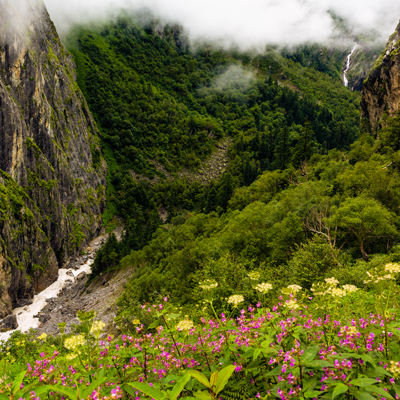
Weather in the Valley of Flowers – What to Expect Through the Season
The Valley of Flowers is not just famous for its blossoms but also for its changing moods through the seasons. The weather here can be gentle one moment and turn misty or rainy the next, which makes it part of the valley’s charm. Here’s what you can expect:
-
Summer Warmth (June – Early July): Days are pleasantly cool with temperatures ranging from 12°C to 18°C, perfect for trekking. Nights can get chilly, so light woollens are a must.
-
Monsoon Magic (Mid-July – August): This is the peak blooming season. Expect light to moderate showers almost daily, mist rolling over the mountains, and vibrant flowers everywhere. Daytime temperatures hover around 10°C to 16°C.
-
Early Autumn Calm (September – Early October): Rainfall reduces, skies turn clearer, and you get golden light over the fading flowers. Days are crisp at around 8°C to 14°C, and nights can drop close to freezing.
-
Sudden Weather Changes: Even in summer, clouds can gather quickly, bringing a surprise drizzle or fog. Waterproof clothing and sturdy shoes are essential.
If you plan your Valley of Flowers Tour Package — whether from Delhi, Rishikesh, Mumbai, or Haridwar — knowing the weather in advance will help you pack right and enjoy your trek to the fullest. Many travelers prefer Valley of Flowers guided tours or fixed departures so they can trek safely with proper support in unpredictable mountain conditions.
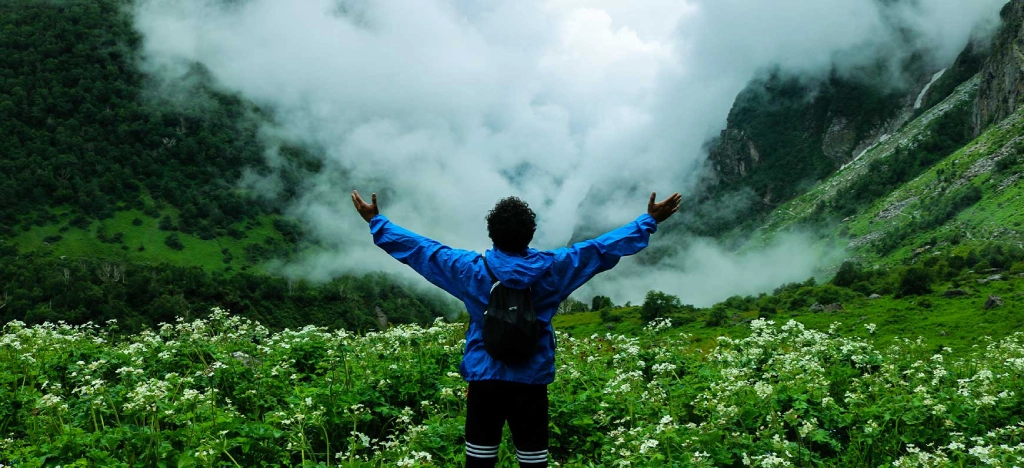
What to Pack and What to Skip for Your Valley of Flowers Trek
Trekking to the Valley of Flowers is a magical experience, but the right packing can make it comfortable and stress-free. Carrying too much will slow you down, and carrying too little can leave you unprepared. Here’s a simple guide:
✅ What to Pack
-
Light Woollens & a Warm Jacket – Even in summer, mornings and evenings can be cold.
-
Waterproof Raincoat or Poncho – Monsoon showers are common during blooming season.
-
Comfortable Trekking Shoes – Sturdy, waterproof shoes with good grip are essential for rocky and wet trails.
-
Backpack with Rain Cover – Keeps your belongings dry during sudden rain.
-
Reusable Water Bottle & Hydration Tablets – Staying hydrated is key at high altitudes.
-
Quick-Dry Trekking Clothes – Light, breathable fabrics that dry fast are best for unpredictable weather.
-
Cap, Sunglasses & Sunscreen – Protects you from strong mountain sun.
-
Personal First Aid Kit – Include band-aids, antiseptic, and medicines for headaches, stomach issues, and altitude sickness.
-
Energy Snacks – Dry fruits, protein bars, or chocolates for a quick energy boost on the trail.
-
Camera or Binoculars – To capture the stunning flora, fauna, and views.
What to Skip
-
Heavy Winter Jackets – The trek is in summer; layered light woollens work better.
-
Expensive Jewelry & Valuables – There’s no need for them in the mountains.
-
Bulky Gadgets – Carry only what’s necessary; a phone or small camera is enough.
-
Too Many Clothes – Stick to quick-dry layers; avoid packing for fashion.
-
Large Bottles of Toiletries – Carry travel-size shampoo, soap, and toothpaste to save weight.
-
Plastic Bags – Use eco-friendly reusable bags instead to keep the valley clean.
-
Formal Shoes or Sandals – Trekking terrain demands sturdy footwear.
-
Books or Heavy Entertainment Items – They add weight; nature will be your best entertainment.
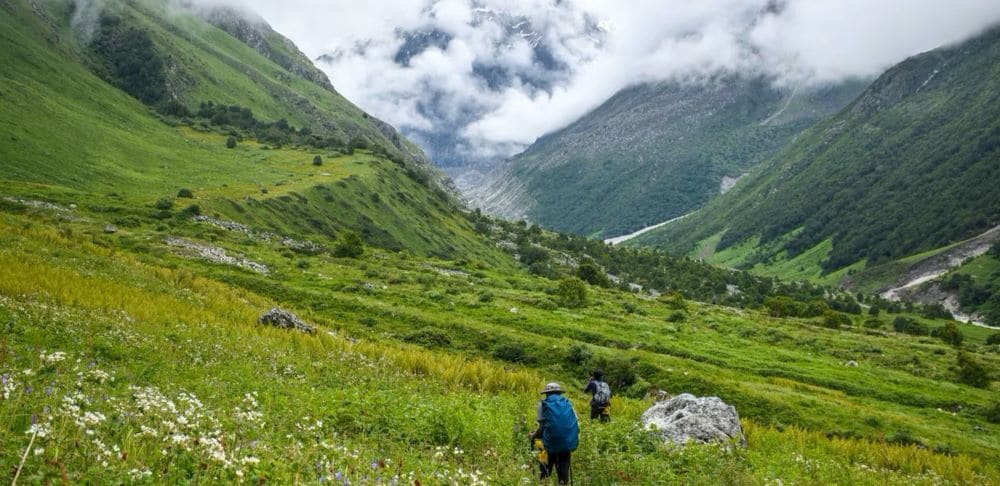
Final Words Before You Go
Visiting the Valley of Flowers trek is like stepping into a living fairy tale — every path has a new splash of color, every breeze carries the scent of wild blooms, and every view feels like magic. This is not just a trek; it’s a slow, peaceful escape into nature’s most beautiful artwork.
Walk gently, breathe deeply, and enjoy each moment without rushing. When you leave, you’ll take more than photos — you’ll carry a heart full of calm, joy, and unforgettable memories of the valley’s charm.
Frequently Asked Questions:
1. When is the best time to visit the Valley of Flowers in 2025?
July to September — when the flowers are blooming beautifully.
2. Is the Valley of Flowers trek very difficult?
It’s a moderate trek — not too hard, but you need basic fitness and stamina.
3. How many days are needed to explore it properly?
3–4 days are enough to enjoy the valley at a relaxed pace.
4. Is it safe for kids and older people?
Yes, if they are healthy and can walk on uneven paths.
5. Can I visit in winter?
No, the valley is closed in winter due to heavy snow.
6. Do I need a guide for the trek?
Not necessary, but a guide can help you know more about flowers and routes.
7. What should I pack for the trip?
Comfortable trekking shoes, warm clothes, raincoat, snacks, and a water bottle.
8. Are there places to stay near the Valley of Flowers?
Yes, most people stay in Ghangaria village.
9. Can I camp inside the valley?
No, camping inside the valley is not allowed.
10. Is photography allowed?
Yes, you can click as many pictures as you want — it’s a paradise for photographers.
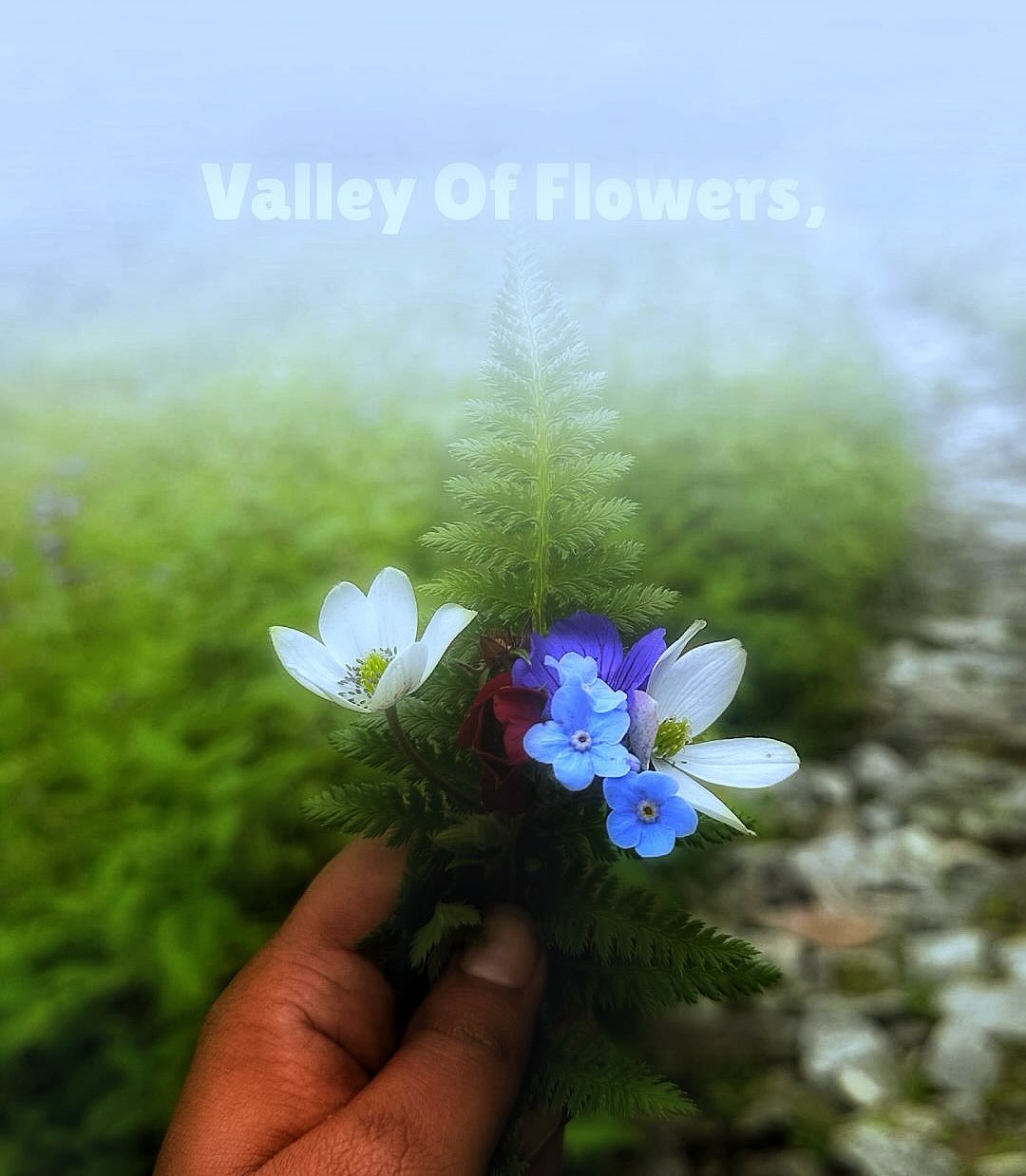

.jpg)
